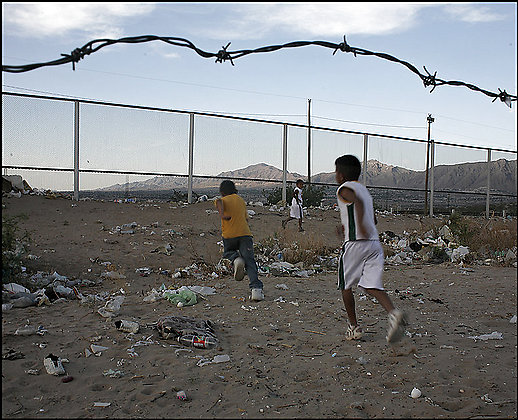DHS Waives Environmental Rules for Border Fence
 I’m scheduled to interview DHS Secretary Michael Chertoff later this afternoon about a new policy announcement and other issues related to his department.
I’m scheduled to interview DHS Secretary Michael Chertoff later this afternoon about a new policy announcement and other issues related to his department.
AP’s Eileen Sullivan highlights the changes:
The Bush administration plans to use its authority to bypass more than 30 laws and regulations in an effort to finish building 670 miles of fence along the southwest U.S. border by the end of this year, federal officials said Tuesday.
Invoking the two legal waivers — which Congress authorized — would cut through bureaucratic red tape and sidestep environmental laws that currently stand in the way of the Homeland Security Department building 267 miles of fencing in California, Arizona, New Mexico and Texas, according to officials familiar with the plan. The officials spoke on condition of anonymity because the waivers had not yet been announced.
The move would be the biggest use of legal waivers since the administration started building the fence, and it would cover a total of 470 miles along the Southwest border. Previously, the department has used its waiver authority for two portions of fence in Arizona and one portion in San Diego.
More from a press release entitled “DHS Exercises Waiver Authority to Expedite Advancements in Border Security”:
The U.S. Department of Homeland Security announced today its intent to issue two waivers of certain laws to expedite security improvements at the southwest border. Congress gave the Secretary of Homeland Security authority to waive all legal requirements necessary to expeditiously install additional physical barriers and roads at the border to deter illegal activity.
“Criminal activity at the border does not stop for endless debate or protracted litigation,” said Homeland Security Secretary Michael Chertoff. “Congress and the American public have been adamant that they want and expect border security. We’re serious about delivering it, and these waivers will enable important security projects to keep moving forward. At the same time, we value the need for public input on any potential impact of our border infrastructure plans on the environment — and we will continue to solicit it.”
One waiver applies to certain environmental and land management laws for various project areas in Calif., Ariz., N.M., and Texas, encompassing roughly 470 total miles. It will facilitate additional pedestrian and vehicle fence construction, towers, sensors, cameras, detection equipment, and roads in the vicinity of the border.
A separate waiver was signed for the levee-border barrier project in Hidalgo County, Texas. This roughly 22-mile project will strengthen flood protection in the area while providing the Border Patrol with important tactical infrastructure. In addition to environmental and land management laws, this waiver addresses other legal and administrative impediments to completing this project by the end of the calendar year.
A substantial portion of the project areas addressed by these waivers have already undergone environmental reviews. In those areas where environmental reviews have not yet occurred, the department will conduct a review before any major construction begins. The department remains deeply committed to environmental responsibility, and will continue to work closely with the Department of Interior and other federal and state resources management agencies to ensure impacts to the environment, wildlife, and cultural and historic artifacts are analyzed and minimized.
The primary source materials: Hidalgo Fence waiver [PDF] and All Segments Waiver [PDF].
My predispositions on this one are contradictory. First, I tend to think a lot of environmental regulations amount to red tape more than actual benefit to the environment. Second, I’m more than a little skeptical that a border fence will do any good. An October 2006 front page WaPo report on this controversy — and the fact that it’s taken this long to issue the waivers — reinforces those views.
Thoughts? Suggestions for questions to ask the Secretary?
Photo Credit: Sarah L. Voisin, The Washington Post
UPDATE: The interview is here: Michael Chertoff Interview – Border Fence, RealID, and Alert Levels. Thanks for your suggestions. I only had a few minutes but got to as many as I could.





From what I’ve seen, DHS and the Bush administration really would rather not build the fence at all. I think it has been seized as an opportunity to appear tough on illegal immigration (hopefully) without having to do anything.
This seems like an opportunity to do more of the same “see, we’re even waiving all sorts of regulations that would normally apply!”
With that in mind, I would try to ask some very specific questions about what is being done. Try to find out whether it’s more building a fence, or more throwing a bone to a vocal lobby.
Just one question: With the massive grassroots effort to have this fence built for so long with little more than token efforts being made by DHS up to now, why now is there such a push to get this built?
It’s disheartening that the government can waive the rules only for itself. While the rest of us bear the costs of overreaching environmental regulations those who write them get a pass.
Like royalty before them governments who do not apply the same rules to themselves show outright contempt for the people. Instead of serving us the government is simply serving it’s own interests first. From city councils to congress we are seeing this more and more, government putting itself ahead of the people.
What are the projected maintenance costs (both financial and environmental) to this whole project? I mean, presumable this is going to be a permanent fixture, and presumable it will be vandalized regularly on top of all the elements of nature taking it’s toll.
It’s not the first question I’d ask, since my goal would be to try to reveal that his job description and his job (as ordered by Bush) are two entirely different things.
But, for an easy question, you could always ask him why he doesn’t discuss the fact that one of the lawyers on the other side has a series of links to a certain foreign government. One guess which government it is. Details at my name’s link.
Ask why CIS contiunes to deport foreign born legal immigrant widows of US citizens and why the dept Chertoff oversees sees this as important. 130 men and women, is it cost effective to deport these people plus fight the class action lawsuit that’s going on at this time?
Bill
I second the Florida Masochist. That’s a ridiculous story that needs telling more broadly.
These descriptions of the regulations being waived are so terse that anyone talking about it will be speaking entirely from their preconceptions.
April Fools!!! Right?? I mean, what kind of moron would place the ecosystem upon which all of mankind depends at risk to bust a few illegal immigrants whose net effect on our economy is a fraction of the cost of keeping them out?
Ha, ha, ha. Good one, James. You had me going there for a second.